When it comes to writing effective Amazon product listings, two main challenges stand out: creating compelling content and crafting attention-grabbing titles. While we have plenty of posts about optimizing your Amazon product images, this guide focuses specifically on how to create concise, informative, and compelling product titles for Amazon that will boost your visibility and conversion rates.
The Crucial Information Needed in an Amazon Product Title
Before diving into title creation, you’ll need a formula to follow as your guideline (Amazon also provides recommendations for title structures). Regardless of what product you’re selling, effective Amazon product titles should contain these essential elements:
- Brand name
- Color, flavor, or variant
- Size and/or quantity
- Key product features
- Relevant keywords
For example, if you’re selling men’s athletic footwear, an effective product title might look like this: “Nike Revolution 6 Men’s Running Shoes, Black/White, Size 14, Breathable Mesh.” This concise version illustrates the basic structure, but Amazon allows up to 200 characters to optimize your title for search visibility.
Amazon Product Title Update [January 2025]
Amazon announced in January 2025 that listings with non-compliant titles will be significantly harder for customers to find on the platform. Starting January 21, 2025, Amazon will automatically adjust non-compliant product titles if suggested changes aren’t implemented within 14 days. During this period, product listings remain active, but if you reject the suggestion, you must provide a compliant alternative to avoid title suppression.
This move has been anticipated, as Amazon’s algorithm now prioritizes listings with titles relevant to customer search terms rather than those stuffed with keywords. The message is clear: if your product titles aren’t properly optimized and compliant with Amazon’s guidelines, your products may become virtually invisible to potential customers.
Amazon Title Requirements and Formatting Rules to Follow
Amazon has specific guidelines for product title formatting that sellers must follow:
- Character limit: Maximum 200 characters, though Amazon recommends keeping titles between 80-100 characters for better readability and mobile display
- Capitalization: Capitalize the first letter of each word (except articles, conjunctions, and prepositions like “and,” “in,” “with,” which should be lowercase)
- Ampersand usage: Write out “and” instead of using the ampersand (“&”), unless the ampersand is part of the product’s brand name
- Numbers: Write numbers as numerals, not words (e.g., use “14” instead of “fourteen”)
- Measurements: Spell out units of measurement rather than abbreviating them (e.g., “Pounds” instead of “lbs”)
- What to avoid: Don’t include prices, promotions, symbols, seller information, or subjective commentary (e.g., “best product”) in the title
- Relevance: Only include color or size in the title if directly relevant (e.g., if an item comes in multiple options)
Word repetition: With the 2025 update, titles may not contain the same word more than twice (prepositions, articles, and conjunctions are exceptions)
Creating Effective Amazon Title Keywords
This is where many sellers underperform. Amazon’s unique algorithm can help your products rank higher in searches when properly leveraged. While factors like price, availability, and sales history impact search ranking, the keywords you use are often the element most within your control.
It’s tempting to prioritize quantity over quality if you’re uncertain which keywords will perform best. However, keyword stuffing (cramming as many keywords as possible into your title) can actually harm your product’s ranking. Instead, invest time in researching which keywords will work most effectively for your products.
Amazon Product Title Best Practices for Keyword Research:
- Think like a buyer: Search for products similar to yours and analyze which items appear first
- Study top-performing listings: Examine the keywords in those titles and identify patterns
- Prioritize high-volume keywords: Place the most important keywords at the beginning of your title
- Maintain readability: Ensure your title flows naturally despite keyword incorporation
- Analyze competitors: Look for less frequently used keywords that high-ranking sellers are using
- Use Amazon keyword optimization tools: Identify relevant search terms with substantial volume
The goal is to emulate successful sellers while creating a unique, clear, and keyword-optimized title that helps you sell more on Amazon.
Boost Your Amazon Reputation
Crafting winning Amazon product titles takes practice, but eventually, it will become second nature. Once you’ve mastered this skill and begin seeing increased sales volumes, make sure you’re using automated feedback software to boost your positive reviews and how to get more reviews on Amazon to further enhance your product visibility and credibility.
By following these Amazon product title best practices, you’ll create listings that not only comply with Amazon’s latest requirements but also attract more clicks and drive higher conversion rates in 2025 and beyond.




